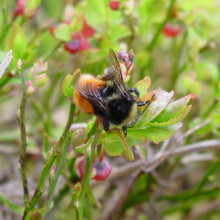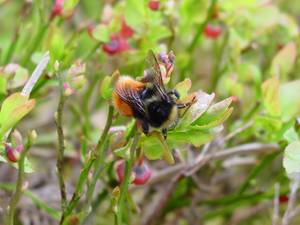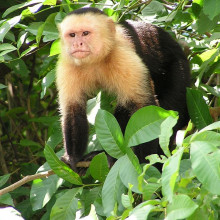On this week's newsflash, we hear how tiny spherical 'nanobees' can be used to treat cancer, how humans were using fire to make tools long before we realised, and how the language of facial expression varies between cultures. Plus, we find out how to make friends with a monkey...
In this episode

Nanobees Sting Cancer Cells
The venom found in bee stings could be used as targeted therapy against cancer, according to a report in the Journal of Clinical Investigation.
 By attaching the venom protein, melittin, to tiny, spherical 'nano-bees', and injecting them into mice suffering with cancer, researchers at Washington university saw tumours either stop growing, or actually shrink. Melittin is a small protein, and works by attaching to the cell membrane and forming pores in the cell, and it's thought that tumours will not be able to develop resistance against this form of attack.
By attaching the venom protein, melittin, to tiny, spherical 'nano-bees', and injecting them into mice suffering with cancer, researchers at Washington university saw tumours either stop growing, or actually shrink. Melittin is a small protein, and works by attaching to the cell membrane and forming pores in the cell, and it's thought that tumours will not be able to develop resistance against this form of attack.
Tumours are known to concentrate certain materials, due to an effect called enhanced permeability and retention which occurs because solid tumours often have leaky blood vessels. This means the nano-bees will build up in the tumour tissue, targeting the cancer directly. Adding extra targeting agents, which are attracted to developing blood vessels, further increases the nano-bees affinity for tumours, and reduced the proliferation of precancerous skin cells by 80 percent in mice.
Melittin is usually broken down by normal biological processes, but by packaging the protein with the nano-bees, it was both protected and kept away from healthy tissue. The core of the nano-bees themselves are made of a chemical called perfluorocarbon, an inert compound used in artificial blood. Each one is about six millionths of an inch in diameter, which is small enough to travel through the bloodstream and attach to the desired cell membranes, but large enough to carry thousands of active compounds.
The nanobees have been tested against two different kinds of cancerous tumours in mouse models; breast cancer cells and melanoma tumours. After the nanobees were introduced, growth of the breast cancer tumours slowed by nearly 25 percent, and the size of the mice's melanoma tumours decreased by 88 percent relative to untreated tumours.
According to Samuel Wickline, 'Melittin is a workhorse, it's very stable on the nanoparticles, and it's easily and cheaply produced." This shows great promise, but it is early days yet, and we don't yet know if it will prove to be a viable clinical application. However, every method we find that can help treat cancer adds to our arsenal, and this one really does have a sting in it's tail.

03:43 - Heat-treating tools
Heat-treating tools
Human ancestors used fire to get the best out of stone tools as much as 164 thousand years ago, according to new research published in the journal Science this week...
Kyle Brown, from the University of Cape Town, and an international team of colleagues, looked at excavations from multiple sites in South Africa, including Pinnacle Point on the south coast, specifically for tool fragments made from silcrete rock.
Silcrete is a finely-grained rock that is traditionally regarded as highly workable in its natural state. Silcrete tools are known to have been made in Australia as well as Africa. However, Brown and colleagues tried it out, and found it to be difficult to shape in a consistent way. Indigenous Australian knappers are known to have treated their silcrete with fire, which changes the crystal structure of the rock, making it much more workable.
Using a number of archaeological techniques, archaeomagnetism, thermoluminescence and gloss analysis, the researchers compared excavated tool fragments with raw or heat-treated samples. Heating a material will change its magnetic properties, especially if heated to above the Curie point, the temperature at which a material loses its magnetic ability. Heating to less than this temperature still leaves a predictable change in magnetic properties, sealing the thermodynamic history into the rock.
Likewise the history can be seen through the amount of light emitted on heating, as heating will allow electrons to be released from a mineral, producing thermoluminescence. Over time, the minerals are exposed to radiation, and build up more potential luminescence. High temperatures can effectively re-set the strength of thermoluminescence, telling you when the mineral was heated, and to what temperature.
These methods confirmed that all of their collected samples had been heat treated. Gloss analysis, a measure of how shiny the surface of the rock is, then confirmed that the tools were shaped after heat treatment, even those found to be around 164 thousand years old, and certainly in tools formed 72 thousand years ago.
Further analysis of the sites showed no evidence for extensive fire, suggesting that these were intentionally exposed to high temperature, rather than caught in a wild fire.
The importance of heat treating is that it allows one to use local, poorer quality materials, and still get the performance of higher quality tools.
This shows a huge intellectual leap from the use of fire for heat and light, and this cognitive change is still not well understood.
From these data, it seems that our ancestors were developing the ability to use fire as an engineering tool in South Africa as much as 164 thousand years ago, and were certainly doing so around 71 thousand years ago from when there is widespread evidence of increasingly complex symbolic behaviour.
This seems to have allowed the development of advanced tools in Africa before their development in the rest of the world, and being able to make the best of local materials could well have been a behavioural advantage when migrating up through Eurasia.

Facial Expressions, Lost in Translation
It's not just the spoken language that can make communication in foreign countries difficult; it seems that easterners and westerners look for different facial cues as well.
It's often assumed that facial expressions form a sort of universal language, but now, Roberto Caldara at The University of Glasgow and colleagues report in the journal Current Biology report that this may not be the case, as eastern observers look for their cues in the eyes, not the full face.
 Caldara and colleagues recorded the eye movements of western Caucasian and East Asian volunteers as they performed an expression recognition task. This consists of identifying the emotion in a number of pictures showing one of seven potential expressions (happiness, surprise, fear, disgust, anger, sadness and neutral). Volunteers were shown images of both same-race and other-race people.
Caldara and colleagues recorded the eye movements of western Caucasian and East Asian volunteers as they performed an expression recognition task. This consists of identifying the emotion in a number of pictures showing one of seven potential expressions (happiness, surprise, fear, disgust, anger, sadness and neutral). Volunteers were shown images of both same-race and other-race people.
East Asian people seemed to make significantly more errors when categorising expressions of disgust and fear, for both the same- and other-race pictures. Fear was consistently confused with surprise, while disgust was confused for anger.
To find out why this may be, they mapped the areas where each volunteer's gaze had been directed while evaluating each image. By mapping the location, frequency and in what order each volunteer looked at what part of the image, they were able to not only find the 'hotspots' that received the most attention, but also spot patterns, such as looking at the right eye, then the left, then back to the right.
East Asian volunteers paid far more attention to the eyes than they did the mouth, especially in the expressions they most often misattributed.
The observers then went on to break each image down for analysis, in an attempt to objectively determine whether sampling the eyes and neglecting the mouth could lead to confusion. Sampling the eye region, they developed a 'pattern of confusions' that showed surprise most likely to be mistaken for fear. Sampling from the mouth region of the images gives a different 'pattern of confusion', where fear and surprise are clearly distinguishable.
So, by fixating their gaze more on the eye area, and neglecting the mouth, East Asian volunteers were more likely to succumb to this confusion, without the correcting effect of observing the mouth.
These results not only indicate that Western and Eastern observers genuinely perceive emotions differently, but also suggest that facial expressions, and especially those used in these sorts of studies, are not universal signals of human emotion. The authors now hope to see how different aspects of culture and ideology affect the results, but meanwhile, we should just buy a good phrasebook if we don't want to get lost in translation!

Monkey See, Monkey Do, Monkey Like
Capuchin monkeys prefer humans who imitate them over those that do not, according to research published in Science this week.
"We often unintentionally imitate the body postures, gestures and mannerisms of our social interaction partners," according to Annika Paukner from the National Institutes of Health Animal Centre in America, who led the study along with colleagues in the US and Italy. When someone imitates us, we like them more, empathise with them more and are even likely to be more generous to them. Imitation clearly plays an important role in inter-personal relationships and social existence, and is thought that the ability to make strong social bonds have an evolutionary advantage over social rejects. If that is the case, it could also be true for non-human primates, such as capuchin monkeys.
To determine if this is the case, Paukner and colleagues tested whether capuchins recognise imitation, and if this leads to a change in social interactions.
 To determine if the monkeys could tell the difference between someone directly imitating them compared with someone doing something merely similar, both the monkeys and the experimenters were given a ball. One experimenter then imitated the capuchins directly, while the other just played with the ball in a way similar to normal capuchin behaviour. The monkeys paid significantly more attention to the imitator, indicating that they are sensitive to imitation. In another experiment, the monkeys chose to be closer to the imitator than a non-imitating experimenter, another indication of a developing affiliation.
To determine if the monkeys could tell the difference between someone directly imitating them compared with someone doing something merely similar, both the monkeys and the experimenters were given a ball. One experimenter then imitated the capuchins directly, while the other just played with the ball in a way similar to normal capuchin behaviour. The monkeys paid significantly more attention to the imitator, indicating that they are sensitive to imitation. In another experiment, the monkeys chose to be closer to the imitator than a non-imitating experimenter, another indication of a developing affiliation.
Knowing that the capuchins responded positively to imitation, a token exchange experiment was set up. This relies on social interaction between monkey and experimenter, as the monkey must present a token in exchange for some food. The monkeys were significantly more likely to approach the experimenter who had imitated them, despite having shown no preference before the experiments began.
According to Paukner, "These experimental results demonstrate that imitation significantly affects the behaviour of capuchin monkeys", and warrants further study to see if similar effects are seen in the wild. As imitation is seen far more often in humans than in other ape species, observing the effects in non-human primates could help to understand how imitation has acted as a 'social glue' throughout our evolution, and could be an underlying mechanism of protective social behaviour in all primates.
In a related 'Perspectives' article, Josep Call and Malinda Carpenter explain that imitation could be communicating a different type of social information, such as dominance structure. If this is the case, the experimenter who is imitating the primates may make himself or herself more approachable not through building affiliation, but by a reduction in social status - The capuchins may then appear to be affiliated merely because they are less fearful.
Either way, it offers a tantalising glimpse into our world as "the ape who apes".









Comments
Add a comment